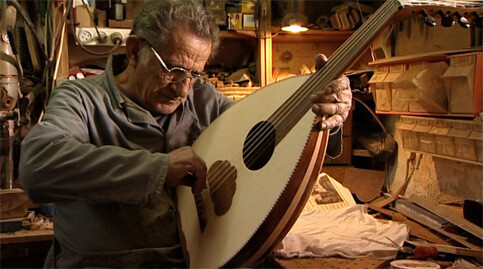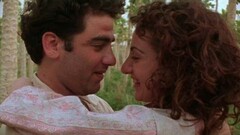The Electronic Intifada 20 April 2009

A scene from Telling Strings.
Swiss filmmaker Anne-Marie Haller’s 60-minute documentary Telling Strings provides a rare look into the profound workings of a Palestinian family of musicians. Initially, the film appears unassuming yet its powerful content, stunning cinematography and informing moments make it a welcomed addition to a long list of documentaries on Palestine. Traversing between the interior and exterior spaces of their lives, Haller captures how culture flourishes within the private realms of Palestinians inside the virtual prison of the Israeli state.
Originally, from al-Rameh village in the northern Galilee, the Jubran family is the focus of the film. It begins with the return of daughter Kamilya from Paris, where she lives and works as a singer/musician. Prior to moving to Europe, Kamilya was a member of Sabreen, a leading Jerusalem-based musical group that later emerged as an influential Palestinian non-profit organization that promotes music education and talent. Her visit serves as a means to revealing the story of her father Elias, a musician and instructor who has been building traditional string instruments such as ouds and bouzouqs in his al-Rameh workshop since 1965.
At first Kamilya narrates her journey home to Palestine. After leaving the airport, she is shown driving down roads lined with Israeli flags as she discusses her village, once considered the capital of Galilee. She comments on al-Rameh’s persistence and survival but admits that its inhabitants “have been losing more and more of their material and spiritual existence to this new entity.” Despite growing up in her ancestral village, Kamilya reveals it wasn’t until she moved to occupied East Jerusalem that she could completely submerge herself in her Palestinian identity “with full consciousness and vitality,” alluding to the many ways in which Palestinians are subjected to an overwhelming sense of isolation. Increasing restrictions on mobility for those living in Israel, the occupied territories or in the diaspora have created a devastating psychological effect on the Palestinian people, one that, as Kamilya contends, reaches the very spiritual and social core of their existence. Yet, as we are shown throughout the film, where local culture can be found, a refuge awaits.
Once arriving in her village, the narrative quickly turns to the stories of each individual member of her family; Kamilya then becomes a type of liaison between the camera and their intimate world. When necessary, she even adopts the role of interviewer, stepping out of the frame in order to draw the viewer into private conversations. Although these exchanges are prompted by questions regarding their interest in music, the topic invariably turns to the conditions they face as “second class citizens” in Israel.
With his wife Nuhad, who once aspired to be a singer, Elias passed on a love of music to his children, all of whom have built on his teachings and created their own paths. Classical Arabic music has thus been a way of life for Kamilya and her brothers since their childhood. Khaled is an Arabic music theoretician who runs the independent Urmawi Centre for Mashriq Music, which supports local musicians and students and regularly organizes concerts and workshops throughout the country. Rabea, although trained in computer science, picked up the bouzouq after moving to Jerusalem.
There is a visible love and mutual respect that is present when Kamilya sits with her father, yet her interactions with Elias are often of a pedagogic nature. His interviews carry much of the film, not only through his authority on music but with the firsthand experiences of life as a Palestinian before and after the 1948 Nakba. Some of the most compelling footage shows Elias recounting when Zionist forces attacked al-Rameh and residents were taken as “prisoners of war.” These testimonies are scattered throughout the film, appearing to ground the narrative in a historical context. He expresses the hardships of daily existence since then and being cut off from the rest of the world. Something as simple as obtaining instruments or sheet music suddenly became nearly impossible after 1948. Out of these circumstances came the need to build his own instruments, the process of which has since become an escape from the reality that surrounds him.
Khaled, on the other hand, maintains a defiant attitude, as is seen in his intellectual approach to both culture and politics, which calls for a nuanced look at classical Arabic music in light of the Western teachings he received in local institutions. Despite experiencing decades of intense prejudice in Jerusalem, he upholds a certain resolve, refusing to let Israeli repression impact his life, work and state of mind. He attempts to maintain his music center in the face of the obstacles imposed on his students and colleagues who are quickly being shut out from the area due to the insurmountable constraints of the checkpoints and wall that are suffocating the neighborhood. For Khaled, there is no other choice but to continue, as a result he often organizes his classes and workshops in makeshift locations throughout the country.
Working at one of Intel’s offices in Israel, youngest brother Rabea describes the constant degradation he faces living in Jerusalem. Even though he is in “a digital world,” where one would expect external politics to remain outside of its confines, he has come to terms with working in a perpetually demoralized state. He cites music as his “true love” and like his father, sees it as an exit from this actuality.
Serving to emphasize the sociopolitical situations of her subjects, the director injects subtle yet powerful scenes of Palestinian neighborhoods enclosed by Israel’s expansive concrete wall. Through a scene of Khaled driving along the massive structure near his music center the viewer gets a sense of the claustrophobic effect it has on the residential and commercial areas it surrounds. In a scene that is both surreal and jarring, the wall stands dismal and brooding against an overcast sky while in a neighborhood only a few feet away from the structure people attempt to go about their daily lives. One can only imagine the landscape or homes that once lay before them, now replaced by this gray abjection.
Another scene shows Rabea playing his bouzouq in his living room, the sounds of which the director infers travel outside to neighboring homes where children stare up at the camera. Haller’s camera cuts to a panning shot of a rooftop view of his Jerusalem suburb, where the imposing barrier can be seen in the distance. The director then returns to Rabea as he finishes his playing; this sequence provides evidence of that which might inform his music.
Various musical recordings by members of the Jubran family serve as a soundtrack for the film, serving to help augment the story and pace the film. Kamilya’s experimental tracks are haunting and sorrow-filled, those played by Elias emit a certain amount of nostalgia, and Rabea’s speak of an attempt to find his bearings. An exquisite portrait, Telling Strings explores the many ways in which culture has provided solace for generations of Palestinians while simultaneously fashioning a sense of resistance within the collective consciousness.
Maymanah Farhat specializes in modern and contemporary Arab art. Her collected writings can be viewed online at http://maymanahfarhat.wordpress.com.
Telling Strings will be screening at the 2009 Chicago Palestine Film Festival.





